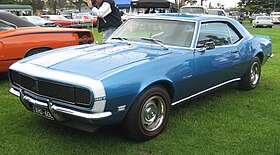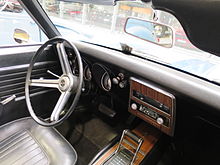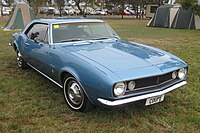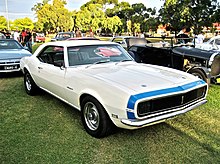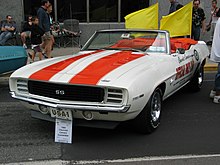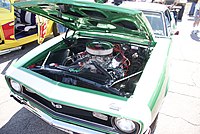
The Pontiac GTO is a front-engine, rear-drive, two-door and four-passenger automobile manufactured and marketed by the Pontiac division of General Motors over four generations from 1963 until 1974 in the United States — with a fifth generation made by GM's Australian subsidiary, Holden, for the 2004 through 2006 model years.
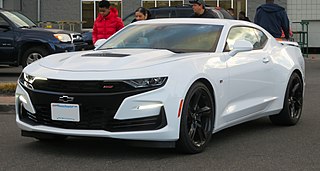
The Chevrolet Camaro is a mid-size American automobile manufactured by Chevrolet, classified as a pony car. It first went on sale on September 29, 1966, for the 1967 model year and was designed to compete with the Ford Mustang. The Camaro shared its platform and major components with the Firebird, produced by General Motors' Pontiac division that was also introduced for 1967.

The Chevrolet Impala is a full-size car that was built by Chevrolet for model years 1958 to 1985, 1994 to 1996, and 2000 to 2020. The Impala was Chevrolet's popular flagship passenger car and was among the better-selling American-made automobiles in the United States.

The Chevrolet Chevelle is a mid-sized automobile that was produced by Chevrolet in three generations for the 1964 through 1977 model years. Part of the General Motors (GM) A-body platform, the Chevelle was one of Chevrolet's most successful nameplates. Body styles included coupes, sedans, convertibles, and station wagons. The "Super Sport" versions were produced through the 1973 model year and Lagunas from 1973 through to 1976.

The Pontiac Firebird is an American automobile built and produced by Pontiac from the 1967 to 2002 model years. Designed as a pony car to compete with the Ford Mustang, it was introduced on February 23, 1967, five months after GM's Chevrolet division's platform-sharing Camaro. This also coincided with the release of the 1967 Mercury Cougar, Ford's upscale, platform-sharing version of the Mustang. The name "Firebird" was also previously used by GM for the General Motors Firebird series of concept cars in the 1950s.
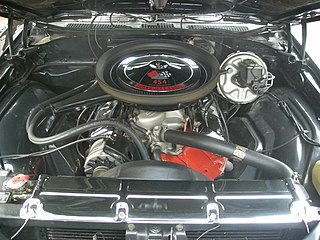
The Chevrolet "big block" engine is a term for a series of large-displacement, naturally-aspirated, 90°, overhead valve, gasoline-powered, V8 engines; that were developed and produced by the Chevrolet Division of General Motors, from the 1950s until present.

The Chevrolet small-block engine is a series of gasoline-powered V8 automobile engines, produced by the Chevrolet division of General Motors between 1954 and 2003, using the same basic engine block. Referred to as a "small-block" for its size relative to the physically much larger Chevrolet big-block engines, the small-block family spanned from 262 cu in (4.3 L) to 400 cu in (6.6 L) in displacement. Engineer Ed Cole is credited with leading the design for this engine. The engine block and cylinder heads were cast at Saginaw Metal Casting Operations in Saginaw, Michigan.

The Chevrolet Chevy II/Nova is a small automobile manufactured by Chevrolet, and produced in five generations for the 1962 through 1979, and 1985 through 1988 model years. Built on the X-body platform, the Nova was the top selling model in the Chevy II lineup through 1968. The Chevy II nameplate was dropped after 1968, with Nova becoming the nameplate for all of the 1969 through 1979 models. It was replaced by the 1980 Chevrolet Citation introduced in the spring of 1979. The Nova nameplate returned in 1985, produced through 1988 as a S-car based, NUMMI manufactured, subcompact based on the front wheel drive, Japan home-based Toyota Sprinter.
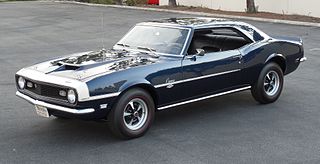
The Yenko Super Camaro was a modified Chevrolet Camaro prepared by Yenko Chevrolet, developed by the dealership owner and racer, Don Yenko, and subsequently aided by special parts ordering directly through Chevrolet.

The Chevrolet Monte Carlo is a two-door coupe that was manufactured and marketed by the Chevrolet division of General Motors. Deriving its name from the city in Monaco, the Monte Carlo was marketed as the first personal luxury car of the Chevrolet brand. Introduced for the 1970 model year, the model line was produced across six generations through the 2008 model year, with a hiatus from 1989 until 1994. The Monte Carlo was a variant of the Pontiac Grand Prix throughout its production.

The Chevrolet Corvette (C3) is the third generation of the Corvette sports car that was produced from 1967 until 1982 by Chevrolet for the 1968 to 1982 model years. Engines and chassis components were mostly carried over from the previous generation, but the body and interior were new. It set new sales records with 53,807 produced for the 1979 model year. The C3 is the third generation of the Chevrolet Corvette, and marks the second time the Corvette would carry the Stingray name, though only for the 1969–76 model years. This time it was a single word as opposed to Sting Ray as used for the 1963–67 C2 generation. The name would then be retired until 2014 when it returned with the release of the C7.

The fifth-generation Chevrolet Camaro is a pony car that was manufactured by American automobile manufacturer Chevrolet from 2010 to 2015 model years. It is the fifth distinct generation of the muscle/pony car to be produced since its original introduction in 1967. Production of the fifth generation model began on March 16, 2009 after several years on hiatus since the previous generation's production ended in 2002 and went on sale to the public in April 2009 for the 2010 model year.

The fourth-generation Chevrolet Camaro is a pony car that was produced by American automobile manufacturer General Motors for the 1993 through 2002 model years. It was introduced on an updated F-body platform but retained the same characteristic since the first-generation's introduction back in 1967: two doors, coupe or convertible bodystyles, rear-wheel drive, and a choice of 6-cylinder and V8 engines. The Camaro was revised in 1998 with both exterior and engine changes. General Motors discontinued production of the fourth generation of the Camaro due to slow sales, a deteriorated sports coupé market, and plant overcapacity.

The third-generation Chevrolet Camaro is an American pony car which was introduced for the 1982 model year by Chevrolet. It continued to use General Motors' F-body platform and produced a "20th Anniversary Commemorative Edition" for 1987 and "25th Anniversary Heritage Edition" for 1992. These were also the first Camaros with factory fuel injection, four-speed automatic transmissions, five-speed manual transmissions, four-cylinder engines, 16-inch wheels, and hatchback bodies. For 1987 a convertible Camaro was reintroduced, converted by ASC in relatively small numbers. The third-generation Camaro continued through the 1992 model year.

The second-generation Chevrolet Camaro is an American pony car produced by Chevrolet from 1970 through the 1981 model years. It was introduced in the spring of 1970. Build information for model 123-12487 was released to the assembly plants in February of that same year. It was longer, lower, and wider than the first generation Camaro. A convertible was no longer available. GM engineers have said the second generation is much more of "a driver's car" than its predecessor. The high-performance Z/28 option remained available through 1975, redesignated as the Z28 in 1972.

The Chevrolet Impala (fourth generation) are full-size automobiles produced by Chevrolet for the 1965 through 1970 model years. The 1965 Impala was all new, while the 1967 and 1969 models featured new bodies on the same redesigned perimeter frame introduced on the 1965 models. All Impalas of this generation received annual facelifts as well, distinguishing each model year. Throughout the early 1960s, Chevrolet's basic body designs became increasingly subtle, while the bright trim that was part of the Impala package added more than a touch of luxury to the look. The same pattern was followed in the interiors, where the best materials and equipment Chevrolet had to offer were displayed. In short, the Impala was on its way to becoming a kind of junior-grade Cadillac, which, for both the company and its customers, was just fine.

The sixth-generation Chevrolet Camaro is an American pony car. Produced by automobile manufacturer Chevrolet, it was first introduced to the public on May 16, 2015. Sales started in 2015 for the 2016 model year. The Camaro now utilizes the GM Alpha platform shared with the Cadillac ATS and CTS and features MacPherson struts in front, rather than the former multi-link setup. General Motors claims that 70 percent of architectural components in the new Camaro are unique to the car.
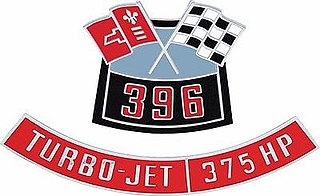
The L78 was a Big-Block engine produced by Chevrolet between 1965 and 1970. Rated at 425 hp (317 kW) for its first year, the rating dropped to 375 hp (280 kW) in subsequent years. Between 1966 and 1969 it was the most powerful Regular Production Option engine available in Chevrolet's intermediate line, making it a highly-collectible muscle car engine today.
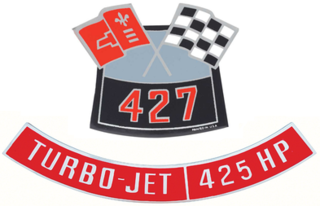
The L72 was a 427 cu in (7.0 L) 90° overhead valve V8 big-block engine produced by Chevrolet between 1966 and 1969. Initially rated at 450 horsepower, the rating dropped to 425 hp (317 kW) shortly after its release. In 1966 it was the most powerful engine available in the Corvette, and between 1966 and 1969 was the most powerful engine available in full-sized models. In 1969 the L72 was available via a Central Office Production Order (COPO) in Chevrolet's intermediate (Chevelle) and pony car (Camaro). Today these vehicles - referred to as COPOs - are among the most collectible 1960s performance cars.

The LT-1 is a Chevrolet small-block engine produced by the Chevrolet Division of General Motors between 1970 and 1972. It was available exclusively in the Corvette and Camaro and was produced in relatively small quantities. It is regarded today as one of the greatest of the Chevy small-blocks, an engine that has been in production since 1955.
